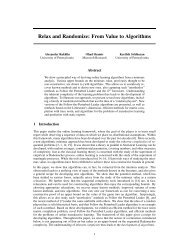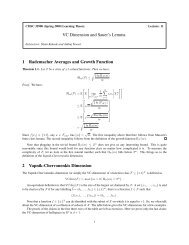Fat Shattering Dimension and Covering Numbers 1 Functions with ...
Fat Shattering Dimension and Covering Numbers 1 Functions with ...
Fat Shattering Dimension and Covering Numbers 1 Functions with ...
You also want an ePaper? Increase the reach of your titles
YUMPU automatically turns print PDFs into web optimized ePapers that Google loves.
CMSC 35900 (Spring 2008) Learning Theory Lecture: 16<br />
<strong>Fat</strong> <strong>Shattering</strong> <strong>Dimension</strong> <strong>and</strong> <strong>Covering</strong> <strong>Numbers</strong><br />
Instructors: Sham Kakade <strong>and</strong> Ambuj Tewari<br />
In this lecture, we will prove a result due to Alon, Ben-David, Cesa-Bianchi <strong>and</strong> Haussler that bound the covering<br />
number of a class in terms of its fat shattering dimension. This provides a result analogous to Sauer’s lemma. As you<br />
remember, Sauer’s lemma gave us a bound on the growth function in terms of its VC dimension.<br />
1 <strong>Functions</strong> <strong>with</strong> Finite Range<br />
Before we prove the result we need a few definitions. Suppose X is some set <strong>and</strong> let B = {0, 1, . . . , b}. Let F ⊆ B X<br />
be a class of B-valued functions on X . Two functions f, g ∈ F are said to be separated if<br />
That is, they are 2-separated in the ℓ ∞ metric where<br />
∃x ∈ X s.t. |f(x) − g(x)| ≥ 2 .<br />
ℓ ∞ (f, g) := max |f(x) − g(x)| .<br />
x∈X<br />
A class F is said to be pairwise separated iff f, g are pairwise separated for all f, g ∈ F.<br />
Definition 1.1. Let F ⊆ B X . We say that F strongly shatters X = {x1, . . . , xn} ⊆ X if there exists s =<br />
(s1, . . . , sn) ∈ B n such that for all E ⊆ {x1, . . . , xn}, there exists fE ∈ F such that<br />
∀xi ∈ E, fE(xi) ≥ si + 1<br />
∀xi ∈ X − E, fE(xi) ≤ si − 1<br />
In this case we also say that F strongly shatters X according to s. The strong dimension of F, denoted by Sdim(F),<br />
is the size of a largest strongly shattered set.<br />
We will shift our attention from real valued functions to ones taking values in a finite set by a simple discretization.<br />
Definition 1.2. Let f : X → [0, 1] be a function. For α > 0, define its discretization f α as,<br />
f α � �<br />
f(x)<br />
(x) := .<br />
α<br />
If F is a function class, define<br />
F α := {f α | f ∈ F} .<br />
Note that f α takes value in the set {0, . . . , ⌊1/α⌋}. The following lemma relates the combinatorial dimensions<br />
<strong>and</strong> packing numbers of the classes F <strong>and</strong> F α .<br />
Recall that we defined the covering number N∞(α, F, x1:n) in an earlier lecture. We define the corresponding<br />
packing number as<br />
M∞(α, F, x1:n) := Mℓ ∞ x 1:n (α, F) ,<br />
where<br />
l ∞ x1:n (f, g) = max<br />
i∈[n] |f(xi) − g(xi)| .<br />
1
Lemma 1.3. Let F ⊆ [0, 1] X <strong>and</strong> α > 0. We have<br />
1. Sdim(F α ) ≤ fat α/2(F)<br />
2. For any x1:n, M∞(α, F, x1:n) ≤ M∞(2, F α/2 , x1:n)<br />
To prove a result bounding the ∞-covering number in terms of the fat shattering dimension, we need the following<br />
combinatorial lemma whose proof we will give shortly.<br />
Lemma 1.4. Let X be a finite set <strong>with</strong> |X | = n <strong>and</strong> B = {0, 1, . . . , b}. Let F ⊆ B X be such that Sdim(F) = d.<br />
Then we have,<br />
Mℓ ∞(2, F) < 2(n(b + 1)2 ) ⌈log y⌉ ,<br />
where y = � d<br />
i=1<br />
� � n i<br />
i b .<br />
Using the above lemma, we can prove a result relating covering numbers to fat shattering dimension.<br />
Theorem 1.5. Let F ⊆ [0, 1] X <strong>and</strong> α ∈ [0, 1]. Suppose d = fat α/4(F). Then<br />
N∞(α, F, n) < 2<br />
�<br />
n<br />
� � � 2en<br />
2 ⌈d log( dα )⌉<br />
2<br />
+ 1<br />
α<br />
Proof. Using the fact that covering numbers are bounded by packing numbers, Lemma 1.3, part 2 <strong>and</strong> Lemma 1.4, we<br />
get<br />
where b = ⌊2/α⌋ <strong>and</strong> y = �d ′<br />
Therefore,<br />
Thus, log y ≤ d log(ben/d).<br />
i=1<br />
N∞(α, F, n) = sup N∞(α, F, x1:n)<br />
x1:n<br />
≤ sup M∞(α, F, x1:n)<br />
x1:n<br />
≤ sup M∞(2, F<br />
x1:n<br />
α/2 , x1:n)<br />
< 2(n(b + 1) 2 ) ⌈log y⌉ ,<br />
� � n i ′ α/2 ′<br />
i b <strong>with</strong> d = Sdim(F ). By Lemma 1.3, part 1, d ≤ fatα/4(F) = d.<br />
y ≤<br />
d�<br />
i=1<br />
≤ b d<br />
� �<br />
n<br />
b<br />
i<br />
i<br />
d�<br />
i=1<br />
� �<br />
n<br />
i<br />
The rest of this lecture is devoted to proving Lemma 1.4.<br />
≤ b d � en<br />
�d d<br />
Proof of Lemma 1.4. Fix b ≥ 2 as the result trivially holds otherwise. For h ≥ 2, n ≥ 1, define the function<br />
t(h, n) = max{k | ∀F ⊆ F, |F | = h, F pairwise separated<br />
⇒ F strongly shatters at least k (X, s) pairs} .<br />
When we say F strongly shatters a pair (X, s), we mean F strongly shatters X according to s. Note that t(h, n) = ∞<br />
when no pairwise separated F of cardinality h exists. Because of the following claim, it suffices to show<br />
�<br />
t 2(n(b + 1) 2 ) ⌈log y⌉ �<br />
, n ≥ y . (1)<br />
2<br />
.<br />
.
Claim 1.6. If t(h, n) ≥ y for some h <strong>and</strong> Sdim(F) ≤ d then<br />
Mℓ∞(2, F) < h .<br />
Proof. For the sake of deriving a contradiction, suppose Mℓ∞(2, F) ≥ h. This means there is a pairwise separated<br />
set F of cardinality at least h. Since t(h, n) ≥ y, F strongly shatters at least y (X, s) pairs. On the other h<strong>and</strong>, since<br />
Sdim(F) ≤ d, if F strongly shatters (X, s) then |X| ≤ d. For any choice of X of size i (there are � � n<br />
i such choices),<br />
there are strictly less than bi choices for s. This is because if<br />
(X, s = (s1, . . . , s |X|))<br />
is strongly shattered then si’s cannot be 0 or b. Thus, F can strongly shatter strictly less than<br />
(X, s) pairs. This gives us a contradiction.<br />
d�<br />
i=1<br />
� �<br />
n<br />
b<br />
i<br />
i = y<br />
To prove (1) by induction, we will establish the following two claims,<br />
t(2, n) ≥ 1 n ≥ 1 , (2)<br />
t(2mn(b + 1) 2 , n) ≥ 2t(2m, n − 1) m ≥ 1, n ≥ 2 . (3)<br />
Any separated functions f, g strongly shatters at least some singeton X = {x} (choose any x such that |f(x)−g(x)| ≥<br />
2), so t(2, n) ≥ 1. To prove (3), consider a set F of 2mn(b + 1) 2 pairwise separated functions. If such a set does not<br />
exist then t(2mn(b + 1) 2 , n) = ∞ so (3) anyway holds. Pair up the functions in F arbitrarily to form mn(b + 1) 2<br />
pairs {f, g}. Call the set of these pairs P . For each pair f, g, fix an x on which they differ by at least 2 <strong>and</strong> denote it<br />
by χ(f, g). For x ∈ X <strong>and</strong> i, j ∈ B, j > i + 1, define<br />
bin(x, i, j) = {{f, g} ∈ P | χ(f, g) = x, {f(x), g(x)} = {i, j}} .<br />
The number of bins is no more than n � � b+1<br />
2 2 < n(b + 1) /2 <strong>and</strong> the numbers of pairs is mn(b + 1) , so for some<br />
2<br />
x∗ ∈ X , i∗ , j∗ ∈ B such that j∗ > i∗ + 1, we have<br />
| bin(x ∗ , i ∗ , j ∗ )| ≥ 2m .<br />
Now define the following two set of functions,<br />
�<br />
F1 := f ∈ � bin(x ∗ , i ∗ , j ∗ �<br />
�<br />
) � f(x ∗ ) = i ∗�<br />
,<br />
�<br />
F2 := f ∈ � bin(x ∗ , i ∗ , j ∗ �<br />
�<br />
) � f(x ∗ ) = j ∗�<br />
.<br />
Clearly |F1| = |F2| = 2m. The first important observation is that F1 is pairwise separate on the domain X − {x∗ }<br />
(which has cardinality n − 1). This is because all f ∈ F1 take value i∗ on x∗ . Similarly F2 is pairwise separate on<br />
X − {x∗ }. Therefore, there exists sets U, V consisting of pairs (X, s) such that F1, F2 strongly shatter pairs in U,<br />
V respectively. Further, |U| ≥ t(2m, n − 1) <strong>and</strong> |V | ≥ t(2m, n − 1). Any pair in U ∪ V is obviously shattered<br />
by F . Now consider any pair (X, s) ∈ U ∩ V . Then, (x∗ ∪ X, (⌊ i∗ +j ∗<br />
2 ⌋, s)) is also shattered by F (remember that<br />
j ∗ > i ∗ + 1). Thus, F strongly shatters<br />
|U ∪ V | + |U ∩ V | = |U| + |V | ≥ 2t(2m, n − 1)<br />
pairs. This completes the proof of (3).<br />
Once we have (2) <strong>and</strong> (3), it easily follows that for n > r ≥ 1,<br />
t(2(n(b + 1) 2 ) r , n) ≥ 2 r t(2, n − r) ≥ 2 r .<br />
3
Thus if ⌈log y⌉ < n, we can set r = ⌈log y⌉ above <strong>and</strong> (1) follows. On the other h<strong>and</strong>, if ⌈log y⌉ ≥ n, then<br />
2(n(b + 1) 2 ) ⌈log y⌉ > (b + 1) n<br />
which exceeds the total number of B-valued functions defined on a set of size n. Thus, a pairwise separated set F of<br />
size 2(n(b + 1) 2 ) ⌈log y⌉ does not exist <strong>and</strong> hence<br />
So (1) still holds.<br />
t(2(n(b + 1) 2 ) ⌈log y⌉ , n) = ∞ .<br />
4




